Choosing the right grow tent size is crucial for a successful indoor cultivation experience. The size of your grow tent influences your plants’ overall health and yield. If you plant too densely, it leads to issues like poor air circulation, increased humidity, and higher chances of disease spread, which negatively affect your plants’ growth.
Before selecting a grow tent size, measuring your available growing space is important. This space should accommodate your garden canopy to include the actual plants you’ll be growing. It affects grow lights – the physical size of the lights and the distance they need to be from your plants.
It also affects the ventilation equipment, including carbon filters, intake/exhaust fans, and clip fans. Finally, it concerns accessories and tools like refilling reservoirs, pumps, soil, nutrients, and shears.
Other key factors to consider when choosing a grow tent size include height, plant type, and cultivation. Taller tents accommodate taller plants or hanging equipment like lights and ventilation systems. Different plants require different amounts of space to grow optimally. Techniques like Sea of Green (SOG) or Screen of Green (SCROG) affect the space needed.
For beginners, a common scenario might involve a 2×2 feet grow tent, which is large enough to house four small-sized plants or two medium-sized ones. For such a grow tent size, you can use a suitable grow light, such as a 150W HPS/MH or a 200W full-spectrum LED light, as they offer enough heat for your plants.
Table of Contents
- What Size Grow Tent Do I Need for X Plants?
- How Many Plants Are in a Grow Tent?
- What Do You Need to Consider When Choosing a Grow Tent Size?
- 1. Type of Plants
- 2. Cultivation Strategies
- 3. Growing Method
- 4. Application of Plant Training
- 5. Grow Tent Shapes
- What is the Best 4×8 Grow Tent?
- What is the Best 3×3 Grow Tent?
- What is the Best 2×2 Grow Tent?
- What is the Best 4×4 Grow Tent?
- What is the Best 8×8 Grow Tent?
- What is the Best 2×4 Grow Tent?
- What is the Best 5×5 Grow Tent?
- What is the Best 10×10 Grow Tent?
What Size Grow Tent Do I Need for X Plants?
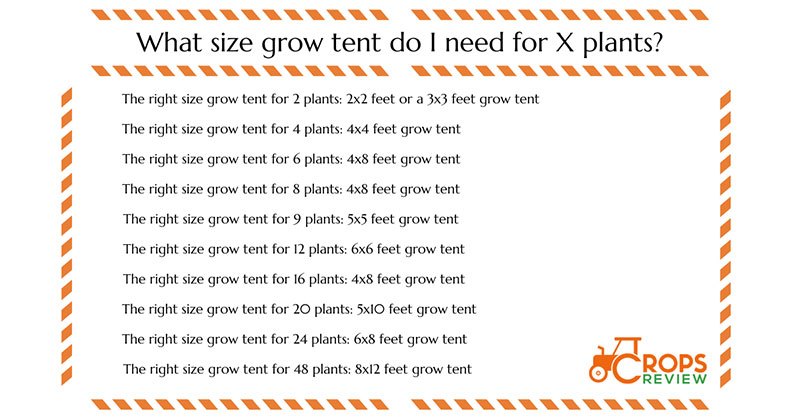
Based on the number of indoor plants, 2 plants, 4 plants, 6 plants, 8 plants, 9 plants, 12 plants, 16 plants, 20 plants, 24 plants, and 48 plants, you can find the right size grow tent.
The right size grow tent for 2 plants is a 2×2 feet grow tent or a 3×3 feet grow tent. Such a grow tent ensures 2 square feet, enough space for your growing needs, and healthy growth for smaller plants.
A suitable size for 4 plants is a 4×4 feet grow tent. Such a size grow tent for 4 plants ensures 4 square feet for your four plants, allows enough room for healthy growth, and easy access to the growing plants in the growing room.
The best size grow tent for 6 plants is a 4×8 size. The 4×8 grow tent offers more space for growing plants indoors and ensures each plant gets enough light and CO2 for healthy growth.
The ideal size grow tent for 8 plants is a 4×8 feet grow tent size. You have enough room for eight large plants in the tent space, but if you want to grow smaller plants, you can grow around 25 in such a tent size.
A good-sized grow tent for 9 plants is a 5×5-foot grow tent. Such a grow tent space offers around 3.1 square feet of space needed for optimal growth and continuous photosynthesis.
The right size grow tent for 12 plants is a 6×6 feet grow tent. This grow tent allows approximately 3 square feet for each plant, and the large grow tent ensures full coverage of the healthy vegetation inside the growing area.
The best size tent for 16 plants is a 4×8 feet grow tent. The grow room ensures 2 soiree feet of growing space for each plant inside for optimal growth.
The ideal size grow tent for 20 plants is a 5×10 feet grow tent. Such a grow room gives each plant 2.5 square feet of growing space to ensure the best growing conditions for the vegetation.
The right size grow tent for 24 plants is a 6×8 grow tent. The grow room ensures 2 square feet of growing space for each of the indoor plants and ensures healthy indoor gardening.
The best size tent for 48 plants is an 8×12 feet grow tent. However, you can also use two 6 x 8 grow tents and divide the plants to offer enough room for healthy plant growth.
How Much Grow Tent Space Does One Plant Need?
The amount of space a plant needs in a grow tent varies depending on the type of plant, the growing method used, and whether you’re growing for personal use or commercially.
A general rule of thumb is to allow 1-2 square feet per plant. The main formula is multiplying your tent’s L x W (length x width). Next, multiply (floor space) x (number of plants you want to grow per sq.m) to calculate how much space you need for how many plants.
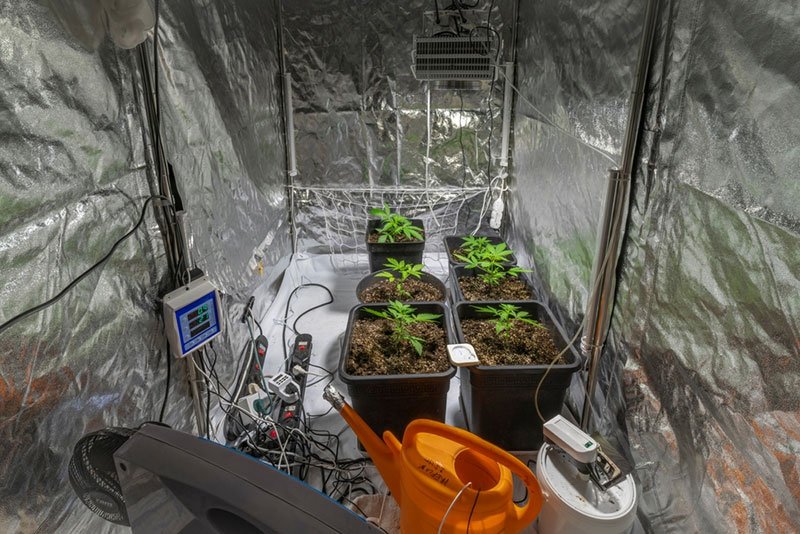
Based on the calculations, there are different scenarios, such as:
Small Grow Tents (less than 2x2ft to 2x4ft):
- Hobby Growing (2 plants): A 2x2ft grow tent is sufficient, giving each plant 2 square feet of space.
- Commercial Growing: Not typically suitable due to limited space.
Medium Grow Tents (4x4ft to 5x5ft):
- Hobby Growing (4-9 plants): A 4x4ft grow tent provides about 1-2.25 square feet per plant.
- Commercial Growing (up to 16 plants): A 5x5ft grow room works, providing a little over 1 square foot per plant.
Large Grow Tents (6x6ft to 8x4ft):
- Hobby Growing (9-16 plants): A 6x6ft grow tent gives each plant about 2.25-4 square feet.
- Commercial Growing (up to 32 plants): An 8x4ft grow tent provides about 1 square foot per plant.
Extra Large Grow Tents (10x5ft and larger):
- Hobby Growing: Not typically necessary unless you’re growing many plants (at least 100).
- Commercial Growing: These tents can accommodate a large number of plants. With a 10x10ft tent, you could grow up to 100 plants, each with 1 square foot of space.
How High Should My Grow Tent Be?
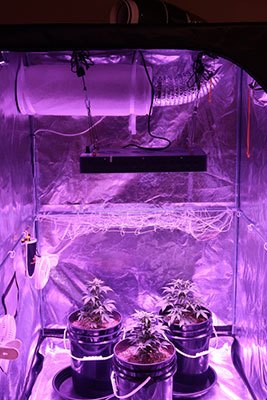
If you’re cultivating cannabis or tall crops like tomatoes, opting for a standard 4×4 grow tent with an 80-inch height is advisable.
Your grow light will be suspended around a foot from your grow tent’s ceiling. The distance between the surface of your plants and your grow light should ideally be 18-24 inches, depending on the intensity of your light.
This configuration immediately consumes around 2.5-3 feet of your tent’s height, leaving approximately 3.5 feet for your cannabis plants to grow. You gain a bit more space if you can hang your grow light slightly higher. While a dimmer for your grow light is used to allow taller plant growth, it compromises light penetration to the lower parts of your plants.
A mini grow tent with a lesser height is sufficient for growing smaller plants like house flowers or succulents.
The common height of grow tent versions for beginners is usually around 5 to 6 feet, providing enough space for the plants, the grow light, and the necessary distance between them.
The extra height in a grow tent can be more expensive, as larger grow tents typically cost more than smaller ones. A large grow tent’s additional space often justifies the price difference, resulting in higher yields if used correctly.
If you find the grow tent you bought too low in height, a few options are available. One option is to use plant training techniques, such as low-stress training (LST), topping, or the Screen of Green (SCROG) method, which can help control the height of your plants.
Another option is to upgrade to a taller grow tent if your budget allows it. Lastly, consider adjusting the hanging height of your grow light if possible, but remember to maintain the recommended distance between the light and the plants to avoid light stress.
How Many Plants Are in a Grow Tent?
The number of plants you can grow in a tent depends on the size of the plants, the type of grow light used, and the growing method. The general guidelines are listed in the table below:
| Grow Tent Size (ft) | Number of Plants | Growing Scenario | Grow Light Capacity |
| 2×2 | 1-4 | Closet | 150-200W |
| 2×3 | 2-6 | Closet | 200-300W |
| 2×4 | 2-8 | Closet | 400-600W |
| 3×3 | 4-9 | Small room | 450-900W |
| 3×4 | 6-12 | Small room | 600-1200W |
| 3×5 | 6-15 | Small room | 750-1500W |
| 4×4 | 9-16 | Bedroom | 900-1600W |
| 4×8 | 16-32 | Bedroom | 1600-3200W |
| 5×5 | 16-25 | Large room | 1600-2500W |
| 5×10 | 25-50 | Large room | 2500-5000W |
| 8×8 | 36-64 | Garage | 3600-6400W |
| 8×16 | 64-128 | Garage | 6400-12800W |
| 9×9 | 49-81 | Garage | 4900-8100W |
| 10×10 | 64-100 | Garage | 6400-10000W |
| 10×20 | 100-200 | Warehouse | 10000-20000W |
However, these general guidelines have their exceptions if there are space constraints. For example, all the above sizes assume you have enough space to accommodate the grow tent. If you’re working with limited space, such as a small apartment or a shared living space, these sizes might not be suitable.
You may need to opt for a mini grow tent or consider other compact growing solutions, such as grow boxes or multi-chamber grow tents, to ensure you have enough space to grow plants.
The above sizes are based on the assumption of medium-sized plants. If you’re growing larger plants, like cannabis plants, or tall vegetables like tomatoes, these growing area models might not provide adequate height. Similarly, if you’re cultivating smaller plants or herbs, a large tent might be excessive.
Larger grow tents and the necessary lighting equipment can be expensive. Starting with a smaller setup might be more cost-effective if you’re on a tight budget.
Larger grow tents require more powerful lights, which consume more energy. A smaller tent with a lower wattage light might be more suitable if you’re concerned about the electricity bill or environmental impact.
Larger grow tents are harder to manage, especially for beginner growers. They require more time for plant care, more effort to maintain optimal climate conditions, and more resources for pest control.
What Do You Need to Consider When Choosing a Grow Tent Size?
If you want to know how to choose a grow tent size for your growing needs, in addition to the tent size of the goring space and how many plants you can grow, consider factors such as grow light type and wattage, budget, ventilation system, easy access, and future expansion.
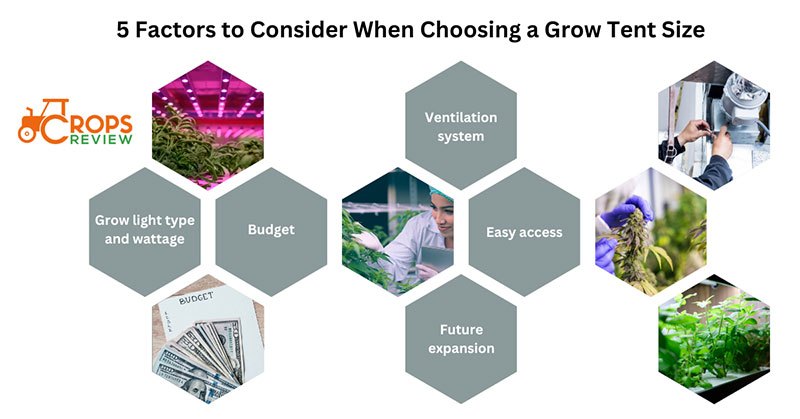
Grow light type and wattage: Different grow lights (HIDs, LEDs, HPS, etc.) cover grow tents effectively. High-intensity discharge (HID) lights generally cover more area than LEDs or fluorescents. Also, higher-wattage lights will cover a larger area.
Budget: Larger tents with higher quality materials, such as metal, mylar, and canvas, will be more expensive.
Ventilation system: You’ll need space for ventilation systems like fans and filters and other equipment like CO2 emitters if you plan to use them. Consider these systems with the size of the tent you choose.
Easy access: Consider how easy it will be to access your plants for regular maintenance. Smaller tents are harder to move around, but larger tents have multiple access points.
Future expansion: It might be worth investing in a larger tent from the start if you plan to expand your growing operation.
1. Type of Plants
Choosing a grow tent based on the type of plants, or “strain,” involves understanding the growth habits and requirements of the specific plants you intend to cultivate. For instance, tomato plants grow quite large, especially indeterminate varieties that continue to grow throughout the season. These plants can reach heights of 6 feet or more, so a tall grow tent is essential. A 4×4 or 5×5 tent would be suitable for a few plants.
Pepper plants are usually smaller than tomatoes, reaching heights of 2-3 feet. They can be grown in smaller tents like 2×2 or 2×4 grow tents.
Herbs like basil, mint, and rosemary don’t require much vertical space but need room to spread out as they grow. A 2×2 or 2×4 tent should suffice for a small herb garden.
Lettuce and leafy greens also stay relatively small and don’t require a lot of vertical space, making them ideal for smaller grow tents. A 2×2 grow tent fits lettuce plants.
2. Cultivation Strategies
Growing plants in a grow tent can be done in two primary ways: continuous harvesting and growing plants in cycles. Each strategy has its advantages and impacts the choice of grow tent size.
Continuous harvesting, also known as perpetual harvest, involves planting new crops regularly so that there are always plants at different stages of growth. This way, you’re able to harvest plants continuously throughout the year.
The key advantage of this method is a consistent supply of plant produce. However, it requires careful planning and organization to ensure that plants at different growth stages meet their needs, especially in light and space.
In terms of grow tent size, this method would typically require a larger tent or multiple tents. You need enough space to separate plants at different growth stages, primarily because flowering plants require a different light cycle than vegetative or seedling plants.
For example, suppose you’re growing cannabis using the continuous harvesting method. In that case, you might want to consider having two tents: a smaller one (such as a 2×2 or 2×4) for seedlings and vegetative plants and a larger one (like a 4×4 or 5×5) for flowering plants.
Growing plants in cycles, also known as batch or staggered planting, involves growing a group of plants together through each growth stage before starting a new batch. All plants in your grow tent will be at the same growth stage.
The advantage of this method is simplicity – all plants require the same conditions simultaneously. Managing lighting, watering, and feeding schedules is easier when all plants are at the same stage.
However, there will be periods when the tent is empty while you’re preparing for the next batch. This downtime can be reduced by starting the new batch of seeds or clones towards the end of the previous batch’s cycle.
The cycle growing method can be more flexible regarding a grow tent size. The size will depend mainly on how many plants you want to grow in each cycle. For example, if you’re growing tomatoes and plan to grow 4 plants in each cycle, a 4×4 tent may suffice.
3. Growing Method
Choosing a grow tent size can also depend on your growing method: soil or hydroponics.
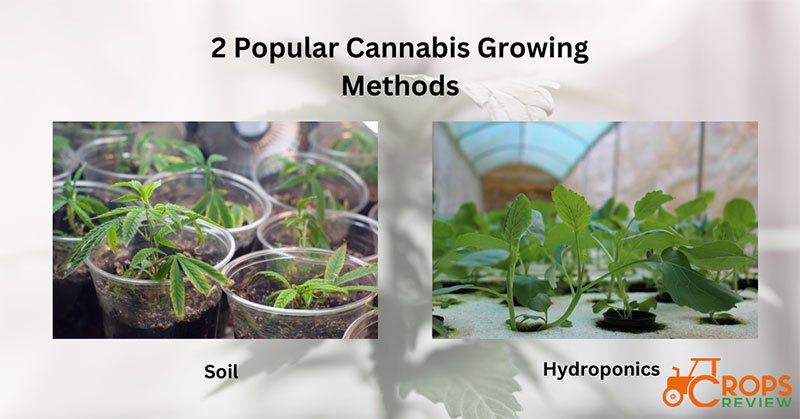
Soil growing is the traditional method of cultivation where plants are grown in natural soil. The soil serves as a nutrient reservoir and water plants need to grow. Beginners often prefer this method because it’s straightforward and requires less technical knowledge than hydroponics.
Regarding a grow tent size, soil-grown plants generally require more space because the soil takes up room. Additionally, soil-grown plants grow larger than hydroponically grown plants, thus requiring more space.
For example, if you’re growing tomatoes in soil, you might need a 4×4 or 5×5 tent for just a few plants due to their size. Similarly, cannabis plants grown in soil often need at least a 3×3 or 4×4 tent.
Hydroponics involves growing plants in a nutrient-rich water solution instead of soil. This method allows for better control over the nutrients the plants receive and can lead to faster growth and higher yields.
However, hydroponics systems can be complex and require more equipment, such as reservoirs, pumps, and air stones. This extra equipment will take up space in your grow tent.
Hydroponically grown plants require less space than soil-grown plants despite the additional equipment. Hydroponic systems allow for closer plant spacing since the roots don’t have to spread out in search of nutrients.
For example, lettuce grown hydroponically could be spaced just a few inches apart, allowing you to fit dozens of plants in a 2×4 or 4×4 tent. For cannabis, a 3×3 tent holds six plants in a hydroponic system, while the same tent would likely only hold one or two soil-grown cannabis plants.
4. Application of Plant Training
Training techniques can alter the size and shape of your plants, thus affecting the amount of space needed. The most popular plant training methods include LST, SOG, and SCROG.
Low-stress training (LST) involves gently bending the plant’s branches to encourage horizontal growth and expose more of the plant to light. LST can make the plant bushier and wider, so you need a larger tent to accommodate the spread.
Sea of Green (SOG) involves growing many small plants close together to create a “sea” of plant tops. The idea is to maximize light exposure and yield without letting individual plants get too large. This training method is space-efficient and enables you to use a smaller tent.
The Screen of Green (SCROG) entails using a screen or net to control plant growth and spreading branches out horizontally to boost light exposure and yield. Like LST, SCROG can make plants wider, requiring a larger tent.
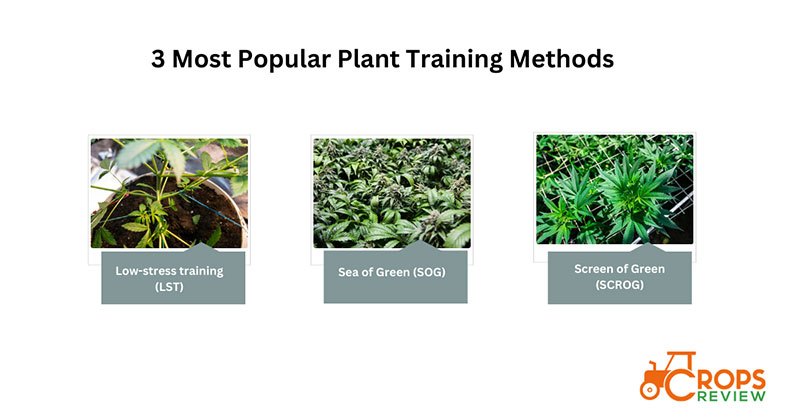
Deciding whether to grow a few large or many small plants depends on several factors, such as cost-effectiveness, maximizing each plant’s yield, and easier maintenance.
Fewer plants mean you’ll need less equipment and resources, such as pots, soil, nutrients, etc.
With more space, each plant has the opportunity to reach its full potential in terms of size and yield.
Fewer plants are generally easier to manage and monitor for pests or diseases.
However, more plants mean more chances for successful growth and a larger total yield, even if each individual plant produces less.
Also, If one plant gets infected or diseased, it’s less of a total loss because you have many others.
5. Grow Tent Shapes
You can also choose to grow tent sizes based on the shapes of your grow tents. You can either choose square grow tents or rectangular grow tents.
Square grow tents typically range from 2×2 feet to 5×5 feet or even larger.
Square tents allow for more uniform light distribution, leading to even plant growth.
They offer flexibility in plant arrangement and can accommodate various plant training methods (SOG, SCROG, LST). Square tents are often easier to set up and manage due to their symmetrical design.
However, square grow tents require more floor space, which could be a disadvantage if you have limited room.
On the other hand, rectangular grow tents come in a wide variety of sizes, from small 2×4 feet tents to large 10×20 feet tents.
Rectangular tents fit better in certain spaces, like against a wall or in a corner, maximizing available space. Larger rectangular tents often have multiple compartments, allowing you to independently separate plants at different growth stages to grow seedlings, vegetative, and flowering stages.
But light distribution is less uniform in rectangular tents, especially longer ones requiring additional grow lights or reflectors. Also, depending on their size, rectangular tents offer less flexibility in plant arrangement, as smaller tents cannot support many plants, and you should use multiple-chamber grow tents or smaller grow tents for the extra space.
If you have limited space or a space that would better accommodate a rectangular shape, then a rectangular tent might be your best option. It’s also a good choice if you’re planning a continuous harvest and need separate compartments for plants at different growth stages.
On the other hand, if you have ample space and want uniform light distribution, a square tent could be a better choice. It’s also ideal if you plan to use plant training methods that require more flexibility in plant arrangement.
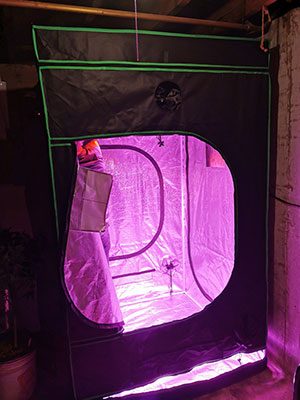
What is the Best 4×8 Grow Tent?
The best 4×8 grow tent is the TopoGrow Grow Tent. The Topogrow grow tent provides enough space to grow 16-32 medium-sized or larger plants. Their construction is also durable and reliable, with metal frames and poles and the 600D reflective inner material to last. The tent provides enough room for around 1200-2000 watts of LED lights.
What is the Best 3×3 Grow Tent?
The best 3×3 grow tent is the Vivosun Mylar Hydroponic Grow Tent. This grow tent is made of mylar and is easy to use, which is beneficial, especially for beginners. It also has durable materials such as metal and steel for construction. The Vivosun Hydroponic grow tent provides enough space for 3-4 medium-sized or larger plants and holds up to 420 watts of LEDs.
What is the Best 2×2 Grow Tent?
The best 2×2 grow tent is the VIVOSUN 24’’x 24’’x 48’’ Mylar Hydroponic grow tent. It’s designed to accommodate four small plants or two medium-sized ones. The tent is made of steel poles with 600D canvas material for its inner setup. It’s good for cannabis plants and supports 220 watts of LEDs.
What is the Best 4×4 Grow Tent?
The best 4×4 grow tent is the AC Infinity CLOUDLAB 844 Advance Grow Tent. It accommodates 4 large plants and allows you to make changes, such as two mature and two small plants. Its design is durable and strong due to 2000D diamond mylar canvas and supports up to 600 LED watts.
What is the Best 8×8 Grow Tent?
The best 8×8 grow tent is the AC Infinity CLOUDLAB 899 Advance Grow Tent. This tent offers thick stick poles and 2000D diamond mylar to support the construction and the plants inside. Thanks to its carbon filter, it eliminates the strong smells and keeps the inner tent part optimal for optimal plant growth. The size supports up to 3600-6400 watts of LEDs.
What is the Best 2×4 Grow Tent?
The best 2×4 grow tent is the AC Infinity CLOUDLAB 642 Advance Grow Tent. It features a solid metal frame with double connectors and zippered openings for entry, viewing, ventilation, ducting ports, and routing electrical cables. The tent also provides rods for grow lights, filters, and fans. It supports 400-600 watts of LED lights.
What is the Best 5×5 Grow Tent?
The best 5×5 grow tent is the GreenHouser High Reflective Grow Tent. It has a full ventilation system with a carbon filter, hydroponics, or soil for optimal plant growth. It also includes environmental control and monitoring, LED grow lights and reflectors. It’s made of 600d Oxford fabric and a metal frame to last and support up to 2500 watts of LED lights.
What is the Best 10×10 Grow Tent?
The best 10×10 grow tent is the VIVOSUN S108 10 x 10 Grow Tent. The grow tent supports up to 10-120 mature plants. It also comes with 600D Oxford fabric and strong metal poles to support the construction and the lighting system. The grow tent supports 2000 watts of LED lights.
